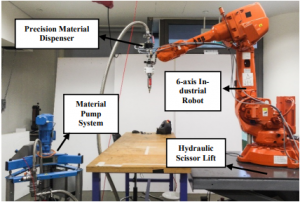 Many people are concerned about the effects of additive manufacturing on the environment, and are making efforts to find ways to 3D print more sustainably. This often involves finding new materials that are more environmentally friendly than, for example, plastic. In a paper entitled “Control of Process Settings for Large-Scale Additive Manufacturing with Sustainable Natural Composites,” a group of researchers describe an additive manufacturing system they developed for 3D printing large-scale objects using natural biocomposite materials.
Many people are concerned about the effects of additive manufacturing on the environment, and are making efforts to find ways to 3D print more sustainably. This often involves finding new materials that are more environmentally friendly than, for example, plastic. In a paper entitled “Control of Process Settings for Large-Scale Additive Manufacturing with Sustainable Natural Composites,” a group of researchers describe an additive manufacturing system they developed for 3D printing large-scale objects using natural biocomposite materials.
According to the researchers, composites made from natural materials with good mechanical properties have been limited in use so far as they are often mixed with plastics or hazardous solvents, and for the most part their use has only been demonstrated on a smaller scale. Because most natural biocomposite materials are water-based, they present their own set of challenges because when they dry and harden, the removal of moisture results in changes in structure and dimension.
In the study, the researchers used a cellulose-chitin material that is both recyclable and compostable. In its dry state, its mechanical properties are similar to that of Rigid Polyurethane Foam. In its wet state, it is pliable and exhibits thixotropy, meaning that it is viscous while in a static state but flows under pressure from an extruder. As it dries, it shrinks anisotropically.
“Our additive manufacturing approach with this material resembles the Direct Ink Write method given the colloidal state of the material used,” the researchers explain. “However as in a Fused Deposition Modelling process, we also employ a filamentary layering approach. With the extruder mounted on an industrial robotic system, the scale of the process extends to the physical reach of the robot.”
The system consisted of three main components: a six-axis articulated industrial robot, a precision material dispenser and a material pump system. Two cameras were used to capture the top and side views of the filaments, allowing the researchers to measure the dimensions of the material. They used mathematical models to “uncover the possible dimensions of a filament that can be obtained within operating boundaries of our system,” and to optimize the machine parameters.
 To test the models, the researchers 3D printed three replicates of filaments with different machine settings. The width and height of the filaments in both wet and dry states were measured along with their tensile strengths upon drying. Overall, the results affirmed the accuracy of the researchers’ models.
To test the models, the researchers 3D printed three replicates of filaments with different machine settings. The width and height of the filaments in both wet and dry states were measured along with their tensile strengths upon drying. Overall, the results affirmed the accuracy of the researchers’ models.
“The linear scaling of shrinkage of overall width along with constant shrinkage in length and height of the repeating units provides valuable insights on developing pathing algorithms which predict and suitably compensate for shrinkage,” they add.
The researchers’ experiments allowed them to develop “the fundamental knowledge pertaining the interplay between the material and the extrusion process, relating controllable parameters to geometric and physical properties of individual filaments.” They identified the lateral overlap settings that fuse filaments together with strength greater than individual filaments, and “mitigated cross-sectional tapering of walls and showed linear scalability of shrinkage models in 3D space which can be used to preset toolpaths and allow for accurate prints.”
Over the course of the study, the researchers successfully 3D printed a vertical single wall tubular structure of 0.25m height, a 1.2m long wind turbine blade and a 5m tall structure composed of multiple ruled-surface segments. More work is required, they state, to understand complex layer compression and bucking phenomena in single and multi-walled structures, and to explore the behavior of free-form designs and internal structural lattice patterns.
“While 3D printing with natural materials is certainly more challenging compared to well-behaved industrial grade material products, positive results towards understanding and controlling 3D printed biomaterials, positive steps towards this direction presented here, may impact general manifesting towards a more sustainable future,” the researchers conclude.
Authors of the paper include Yadunund Vijay, Naresh D. Sanandiya, Stylianos Dritsas and Javier G. Fernandez.
Discuss this and other 3D printing topics at 3DPrintBoard.com or share your thoughts in the comments below.
Subscribe to Our Email Newsletter
Stay up-to-date on all the latest news from the 3D printing industry and receive information and offers from third party vendors.
You May Also Like
3D Printing Financials: Fathom Struggles in Financial Quicksand During Critical Transition
Facing a year of key transitions and financial pressures, Fathom (Nasdaq: FTHM) has filed its annual report for 2023 with the U.S. Securities and Exchange Commission (SEC). The document outlines...
Latest Earnings Overview for Australian 3D Printing Firms Titomic and AML3D
Australian 3D printing manufacturing firms Titomic (ASX: TTT) and AML3D (ASX: AL3) reported their financial results for the period from July to December 2023, marking the first half of their...
3D Printing Webinar and Event Roundup: April 7, 2024
Webinars and events in the 3D printing industry are picking back up this week! Sea-Air-Space is coming to Maryland, and SAE International is sponsoring a 3D Systems webinar about 3D...
3D Printing Financials: Unpacking Farsoon and BLT’s 2023 Performance
In the Chinese 3D printing industry, two companies, Farsoon (SHA: 688433) and Bright Laser Technologies, or BLT (SHA: 688333), have recently unveiled their full-year earnings for 2023. Farsoon reported increases...
































